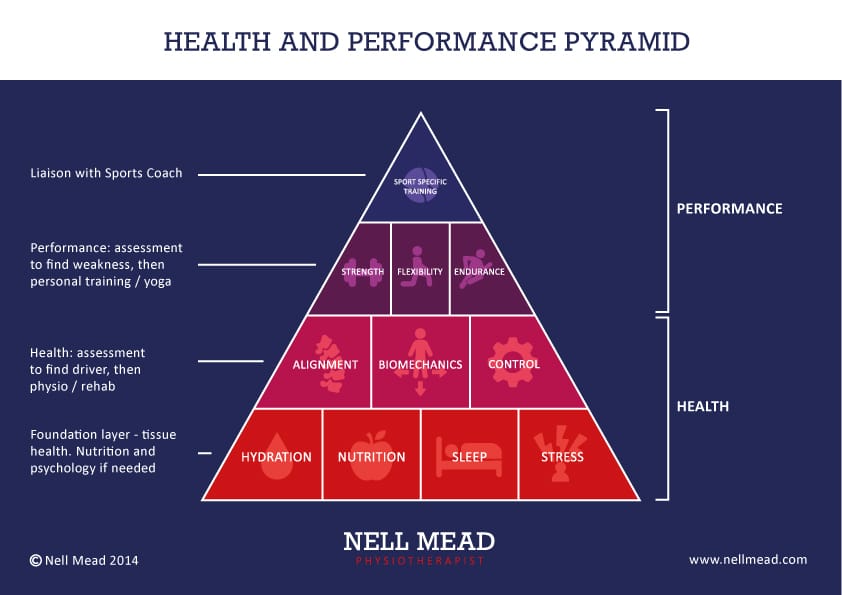Over the past few weeks, we’ve been looking at my Health & Performance Pyramid. We’ve introduced it, and then started to look at the Foundation Layer – explaining the importance of sleep, stress, hydration and nutrition, and what you can do to improve them. This week, we’re moving up to the Health layer, and specifically, starting with physiotherapy. So… why is my physiotherapy practice so different from the usual?

The first difference is that I don’t only look at the bit that hurts. In fact, that’s often the last thing I’m interested in! Most competent physiotherapists can work out which piece of tissue (ligament, cartilage, tendon, muscle) is hurting. They can do standard orthopaedic tests, they can prod you about, and they can diagnose a strain or a tear, or a compressed spinal disc.
However, very few of them look deeper, and try to work out why the bit that hurts is under strain in the first place: why did that disc get damaged? Why did that muscle tear?
You see, having an injury is a bit like having a light bulb that constantly fuses. You need to work out if the problem is in the faulty light bulb, or whether it’s actually in the fuse box or the wiring. Because there’s no point in constantly replacing the bulb if it’s just going to blow again… and similarly, if you keep sitting with your head too far forward, or your pelvis twisted; or walking with all your weight on the outside of your foot… whatever the underlying cause of your problem is, if you keep doing it, then there’s no point just treating the bit that hurts, because you’ll go straight back to your old movement patterns and hurt it again.
I believe that my job as a physio is to be the detective, to find the “criminal” that’s causing the pain and to rehabilitate it, and not just to treat the “victim” and hope that the underlying cause will sort itself out. This doesn’t mean I will never treat the painful area, but it does mean my treatment will be a bit more in-depth and thorough! My assessment session is a full 90 minutes, which gives me time to really get to the “criminal” and to work out a plan of action.
Having found the cause, I’ll then treat both the cause and the painful area (using hands-on treatment such as joint mobilisation and massage), and teach you to reintegrate them into normal, functional movement patterns (with specific exercises), with good joint space, alignment and muscle tone all harmonising to putting your body into an optimal state for healing. My treatment sessions are an hour long, which gives us the time to make real progress in each session. This is what I consider to be “good physiotherapy”.
I should also mention two acronyms you’ll hear me talking about a lot: RSM and ABC.
When I talk about “your ABCs”, I don’t mean your alphabet! I’m talking about the things I’m working to help you achieve during treatment – good Alignment, Biomechanics and Control – because once you’ve got these down pat, you’re in a good state for healing.
“RSM” is the way we achieve the ABCs – we Release the tight power muscles that tend to go into spasm when you have pain or dysfunction, teach you to Stabilise with the little postural muscles that tend to become inhibited and slow when you’re in pain; and then teach you to Move better, because normal movement doesn’t hurt.
Do you need to work on your ABCs to get out of pain? If so, why not contact my team on 0207 175 0150, and book in for a 90-minute physio assessment.







